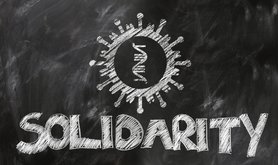
Thirty articles on nonviolent protest
Even under aggressive provocation, nonviolence remains the key to success in the struggle against injustice.

The killing of George Floyd, an African-American man, by Derek Chauvin, a white policeman in Minneapolis on May 25 2020 has unleashed a worldwide wave of protests against racism and police brutality. Though most of these protests have been nonviolent (even under provocation from aggressive policing and the presence of military forces on the streets), looting, property destruction and attacks on security personnel have also occurred, though exactly who is responsible is unclear. There is evidence of infiltration by far-right agitators as well as coordinated actions by so-called ‘antifa’ and ‘black bloc’ anarchists on the left (“The truth is, nobody really knows,” said Keith Ellison, Minnesota’s attorney general, on NBC’s “Meet the Press”). This has revived an old but crucial debate about the use of violence in defense of human rights.
As a section of openDemocracy, Transformation is committed to nonviolent action as the centerpiece of struggle (self-defense notwithstanding), because we believe that violence leads to more violence further down the line. To make lasting progress that cycle must be broken. But nonviolence is a complex and challenging field of strategy, methodology and tactics which are always context-specific, eschewing easy generalizations about ‘what works’ from one time and place to another. To explore these complexities - and often borrowing material from incredible partners like Waging Nonviolence and YES! Magazine - we have published over fifty articles on nonviolent protest since 2013. Here are 30 of the best which provide important guidance both now and in the future.
Perhaps the best place to start is with this piece which has been read over 50,000 times since the protests began last week – a clue to how useful it is in understanding the realities of structural racism and white privilege as the underlying causes of police violence and other forms of race-based oppression (even if you think you are ‘woke’):
The death of George Floyd, of course, was only the latest in a long line of similar incidents that stretches back through Eric Garner in New York and Michael Brown in Ferguson to Rodney King in Los Angeles in 1992 – along with so many others. This shameful history produced a string of early and powerful articles on the site which also covered the development of Black Lives Matter in response:
Why I want to burn everything down right now - and why I’m not going to, by James Edwards
What are white folks to do? From Trayvon Martin to Michael Brown, by Claudia Horwitz
#Black Lives Matter makes some people angry. Isn’t that good? By Alexis Buchanan
#Black Lives Matter and progressive color blindness, by Scot Nakagawa
The protests that spread from city to city around each of these killings were characterized by lots of creativity and innovation in tactics and strategies, practiced by a wide range of groups which differed in their approaches and were often only loosely-affiliated with one-another. One particular point of contention emerged around the use of physical violence and the targeting of property by certain elements in these protests, which were supported by some contributors because they exerted more pressure and opposed by others on the grounds that they were actually counterproductive:
Can antifa build a broad-based antifascist movement? By Brian Martin and Sue Curry Jansen
The strategic naiveté of Antifa, by Molly Wallace
Why black bloc tactics won’t build a successful movement, by Kazu Haga
Smashing egoism: against flashpoint activism, by Bellamy
What’s the point of flashpoint action? By Yalla Matame
Nevertheless, the great majority of the articles we published or reposted were explicit in their commitment to nonviolence at all times. Some of these pieces looked back through history to find arguments and evidence in support of this position, including the struggle for Irish independence, the movement against the Vietnam War, and even the power of nonviolent resistance during World War Two (usually the most difficult case for advocates of nonviolence to sustain):
What can be learned from recent studies on nonviolent action? By Brian Martin
Why understanding the history of nonviolence is essential, by Tristan Husby
The Irish Revolution’s overlooked history of nonviolent resistance, by David Carroll Cochrane
Five movies that show the power of nonviolent resistance during World War II, by Bryan Farrell
Other contributors focused on more recent history and the need to learn lessons from contemporary nonviolent protests. Especially important were pieces written by direct participants in these protests or by activist-researchers who attempted to systematize what was happening in order to identify common patterns and their underlying drivers. Kazu Haga was one of the most prominent of these contributors:
The problem of wanting ‘peace’ in Baltimore, by Kazu Haga
Why the moral argument for nonviolence matters, by Kazu Haga
Why we need to move closer to Martin Luther King’s understanding of nonviolence, by Kazu Haga
Violence brought us Trump but it’s not how we will stop him, by Kazu Haga
Meanwhile, two veterans of the peace movement who have been studying and practicing nonviolence since the 1960s - Michael Nagler and George Lakey - produced an invaluable series of overviews that linked different experiences together and showed how new protests can learn from older ones to create an ever-evolving repertoire of methods and techniques that can be taught to, modified, and extended by each generation in turn:
Six Principles of nonviolence, by Michael Nagler
Love at the barrel of a gun, by Michael Nagler
How to fight fascism from a position of strength, by Gorge Lakey
How can allies protect communities threatened by violence? By George Lakey
Other common lessons include the need for rigorous training and preparation in the practice of nonviolent resistance (especially in the face of aggressive policing and other similar intimidation); how to identify and work with allies in ‘unlikely places’ in order to gain more traction (such as the armed forces and the police); defusing tension at points of confrontation by using humor and other ‘constructive’ practices; and transmuting emotions like anger and hate into a positive source of power and connection – and a potential source of transformation:
Transforming anger into nonviolent power, by Stephanie van Hook
The limits of non-cooperation as a strategy for social change, by Stephanie van Hook
Why are Nazis so afraid of clowns? BY Sarah Freeman Woolpert
The transformation of a warrior behind bars, by Kazu Haga
How movements build strength through training, by George Lakey
These articles contain a wealth of material on nonviolent protest, and no doubt more will be added as the current wave continues. They are all well worth reading and sharing – and be sure to subscribe to Waging Nonviolence and Yes! Magazine which is where many of them originate. Rivera Sun’s Nonviolence News and the Metta Center for nonviolence are also essential resources.
They don’t reveal one single conclusion or a universal truth, but especially at a time when some media attention is refocusing on looting and violence (are the protests ‘riots’ or ‘uprisings?’), it’s worth remembering something that Kazu Haga once wrote about what’s really at stake: “nonviolence isn’t just the absence of violence; it’s a stand against injustice and a commitment to repair harm.”
Read more
Get our weekly email





Comments
We encourage anyone to comment, please consult the oD commenting guidelines if you have any questions.